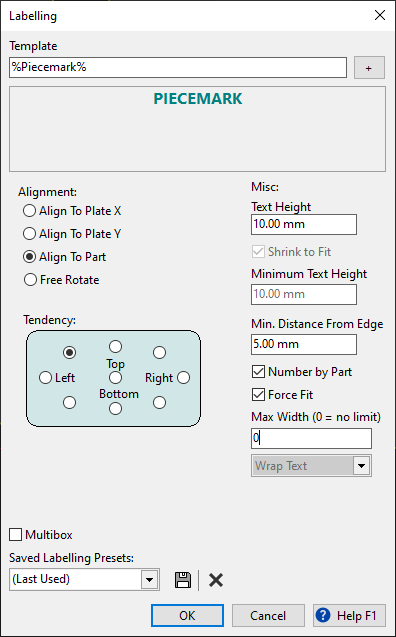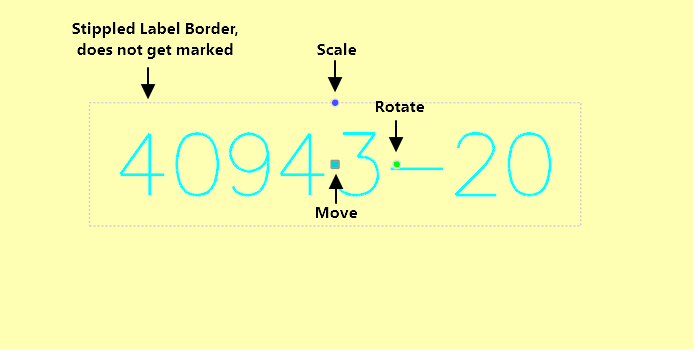You can also apply labels when editing the parts themselves, similar to Label Parts on Plates. Part labels are distinguishable from regular text entities as they are rendered on screen with a stippled boundary. They are moveable via their handles in the Processing Editor as well as in Geometry Editor, unlike regular text.
Not all information is available to the labeling template at the part editing stage: all plate information for example won't be populated until the part is actually nested on a plate.
Further, other information, such as Part name, Customer Name, Job Number, Piecemark may not yet be finalized, or the part may be re-used in multiple jobs requiring them to change.
When a macro value is not available, it is resolved with the preview data. Macros are completely resolved when the part is actually nested on a plate. This ensures correct values will be substituted for the macros. For example if %PartID% was used and it was resolved immediately to 1234, then the part was edited creating a new revision, the label would still be 1234, which would now be incorrect.


Move, Scale and Rotate handles are available in the Processing Editor on Part Labels when selected.
Most commonly Part labeling is used with Part and Workorder macros.
Macros are not resolved on the part, they are resolved and replaced as the part is nested onto plates.
Note the part labeling fields are stored in the part information, not the workorderitem, and so cannot refer to things like Invoicenumber (a workorder property) or Piecemark (a line item property); these fields are left encoded in the part label, and fully resolved only when the part is nested on a plate as a workorderitem.
%PlateID% Replaced with the PlateID
%PlateSerial%, %PlateHeat%, %PlateTestCert% Replaced with The plate audit data, but only if set on the plate.
%Piecemark% will be kept as %Piecemark% on the part, as the part can be reused under multiple workorders using different piecemarks; if late binding (see abobve) is in effect it will be updated as the workorder item (which owns the piecemark) is nested.
You can also enter $PLATE_HEAT$ or $PLATES_SERIAL$, this is binding of the plate's heat and serial number, and will be applied via Postprocessor macros as the program is scheduled as the NC codes are being generated. In this way parts can be nested onto plates before heat and serial number is known, and so long as the Heat and Serial number are entered before it is scheduled. If a plate is rescheduled, or parts are moved between plates, these postprocessor plate information macros ($...$) will update accordingly, whereas %PlateID% etc will not, as they have already been replaced with the original plate value as the part was nested.
Finally, the latest binding possible is when the machine operator keys the heat and serial number in within Touchcut when using Touchcut Integration. If <PlateHeat> or <PlateSerial> are used, they will be passed through untouched by PrimeCut and embedded in the G codes the machine reads. Touchcut will then recognize them and substitute them automatically for the Heat and Serial numbers keyed in. Strict Audit should be anbled to ensure these have been set. If a program setup this way is run outside of the Touchcut Integration, for example if the network is down and its loaded from a USB stick, then the machine operator may need to do a search and replace in the NC codes before activating and running the program. (M22 enables code replacements; M23 disables them in Touchcut)